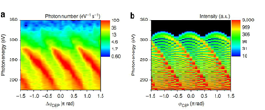Generation of Isolated Attosecond Soft X-Ray Pulses in the Water Window
Itatani Group
High harmonic generation using Ti:sapphire lasers at 800 nm is well established in 1990’s, and has opened a way to produce attosecond optical pulses in the extreme ultraviolet (EUV). The spectral range of such attosecond pulses, however, remains in the EUV (< 200 eV in photon energy, or > 5 nm in wavelength). It has been expected that the spectral range of attosecond pulses can be drastically extended to the soft X ray region by using an ultrashort light source in a longer wavelength because low-frequency strong fields can accelerate electrons to much higher kinetic energies. The accelerated electron’s kinetic energy is then converted to a photon energy in the recombination process of high harmonic generation. However, such ultrashort-pulse infrared (IR) sources have been not available because of the lack of appropriate laser media in the IR or mid IR.

Fig. 1. (a) Experimentally obtained high harmonic spectra recorded with varying the CEP with steps of 0.1 π radian. (b) Simulated high harmonic spectra assuming 10-fs optical pulses at 1600 nm with an intensity of 3.8×1014 W/cm2.
Here we report on the recent breakthrough in producing isolated attosecond pulses in the soft X ray region (up to ~325 eV in photon energy) by using a newly developed IR light source that is based on optical parametric chirped pulse amplification (OPCPA). The OPCPA, unlike chirped pulse amplification in Ti:sapphire lasers, is based on parametric amplification in nonlinear transparent crystals. By appropriately selecting the nonlinear crystals, pump lasers, and phase-matching conditions, we can design the spectral properties of optical amplification. We have developed a full-scale OPCPA system that uses BiB3O6 (BIBO) crystals as nonlinear media and a Ti:sapphire laser system around 800 nm as a pump source. With this novel combination of BIBO and Ti:sapphire, the BIBO-based OPCPA exhibits an extremely broad gain bandwidth spanning from 1100 to 2200 nm. This nearly-octave spanning bandwidth enables us to amplify few-cycle IR pulses directly in the OPCPA system. We have successfully produced 0.55-mJ, 10-fs pulses centered at 1600 nm at a repetition rate of 1 kHz. This pulse duration corresponds to sub-two cycles of the carrier wave at 1600 nm. The output of the OPCPA system was focused onto a gas cell containing neon to produce high harmonics. We observed soft X-ray spectra of high harmonics up to 325 eV, which is well reaching the water window or covering the carbon K edge. The spectral structure below the cutoff was observed to be extremely sensitive to the carrier envelope phase (CEP) of the driver pulses. By changing the CEP, we observed a drastic shift of the peak structure in the soft X-ray spectra. This behavior is known as a half-cycle cutoff, which is an important signature for the production of isolated attosecond pulses.
This work is indeed a milestone to extend attosecond spectroscopy from the EUV to the soft X ray, where we are aiming the first demonstration of ultrafast soft-X-ray spectroscopy that can probe element-specific electronic states of condensed matters. Such laser-based ultrafast soft X-ray sources are expected to play an important role, which is complementary to other soft X-ray sources such as 3rd generation synchrotrons and X-ray free electron lasers.
References
- [1] N. Ishii, K. Kaneshima, K. Kitano, T. Kanai, S. Watanabe, and J. Itatani, Nature Commun. 5, 3331 (2014).
